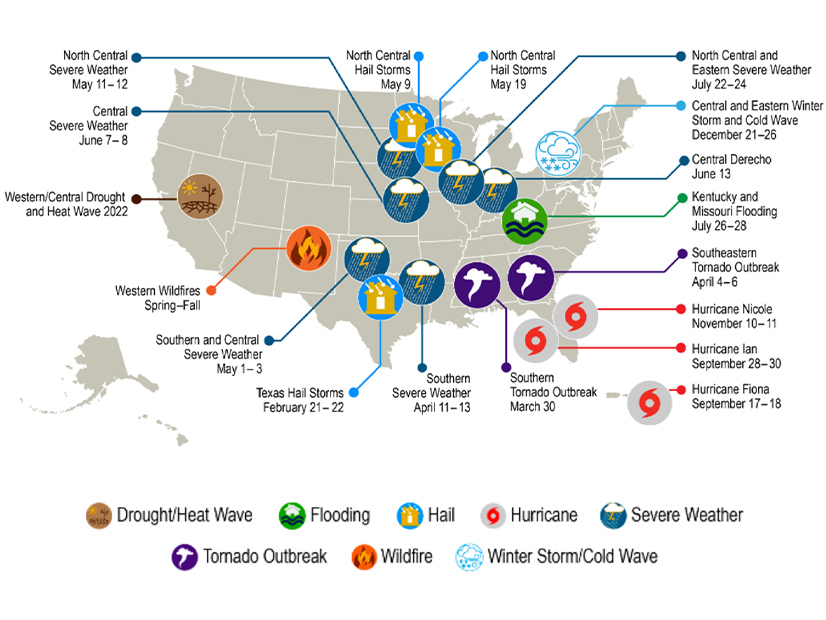NERC on Thursday released its 2023 State of Reliability report, which found that the North American bulk power system generally remains highly reliable and resilient.
Transmission system reliability has improved significantly for the fifth consecutive year, but conventional generation — challenged by more frequent extreme weather — saw its highest level of unavailability overall since NERC started gathering generator availability in 2013.
Generation saw its worst “weighted equivalent forced outage rate” last year, Manager of Performance Analysis Donna Pratt said on a conference call with reporters Thursday.
“When we analyze this by fuel type, we also observed increasing outage rates for coal over the five-year period, which correlates to higher numbers of start-ups and maintenance outages,” Pratt said. “And the unavailability of gas-fired generation recently has been consistently higher during the winter months.”
Those are two of the main reasons why generation is “surpassing transmission in contributing to major load-loss events,” she added. No apparent trends are discernable in other forms of generation, the report said.
“Higher overall outage rates for coal and gas generation, as well as some utility-scale solar generation not operating as necessary for reliability, indicate that there is still significant work to be accomplished to accommodate the rapidly changing weather and generation resource mix in conjunction with electrification of the economy in a reliable manner,” said Pratt.
The most significant reliability event of the year was the winter storm in December, also known as “Elliott,” which impacted the eastern U.S. and prompted a joint inquiry from FERC and NERC into what happened. The inquiry is expected to be completed late this year, so NERC’s report did not go into depth on Elliott. (See FERC, NERC Set Probe on Xmas Storm Blackouts.)
But in response to that and other recent cold weather events, NERC issued a Level 3 “essential action alert” this May to tell the industry to increase its winter preparedness. NERC has issued several new standards on winter readiness this year, and others are under development.
NERC’s report also highlighted a June 4, 2022, event around Odessa, Texas, where a failed surge arrestor caused the loss of 333 MW of synchronous generation, leading to the erroneous loss of another 511 MW and an unexpected loss of 1,700 MW of solar PV generation.
“The total generation lost exceeded the most severe single contingency and nearly exceeded the Texas Interconnection resource loss protection criteria, the design threshold that is used to establish the requirements for frequency recovery in the Texas Interconnection,” the report said.
That event and other similar ones indicate that the dynamic performance of inverter-based resources (IBRs) have to be improved if the grid is to benefit from their rapid expansion, NERC said.
Texas has had similar events with IBRs, as has the Western Interconnection, and NERC has highlighted the issues with IBRs since 2016. NERC is working to upgrade its standards to address the issue, and FERC launched a rulemaking on it last year. (See FERC Addresses IBRs in Multiple Orders.)
Immediate industry actions are needed to implement published guidelines and ensure the reliable operation of the grid as IBRs grow.
“IBR modeling requirements need significant improvement to ensure that high-quality, accurate models are used during reliability studies so performance issues can be identified before they occur during real-time operations,” NERC said.
Physical and cyberattacks on grid assets are increasing, and that reinforces the need for the further development and adaptation of standards and guidelines.
“The growing attack surfaces that result from the increasing penetration of distributed energy resources call for ongoing development and adaptation of cyber and physical security standards and guidelines to keep up with the ever-changing threat landscape,” NERC said. “Furthermore, cyber-informed planning should include designs and be considered when planning and integrating the technologies into the grid to strengthen the cyber robustness.”
Hostile nation states are continually targeting North American critical infrastructure and are constantly evolving methods to compromise the grid’s security, reliability and resilience. Homegrown extremists have also targeted the grid, NERC added.




